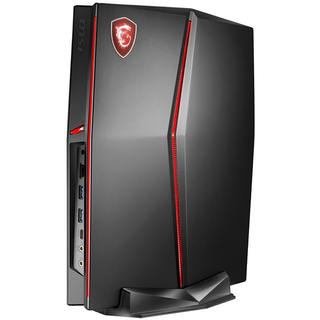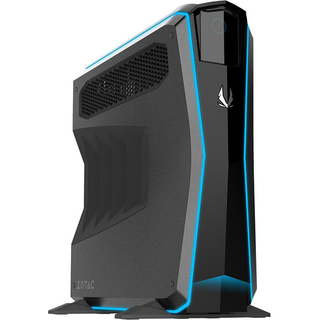Zotac Mek1 Desktop Review: Killer 1440p Gaming
Why you can trust Tom's Hardware
Synthetic & Productivity Benchmarks
We didn’t manage to work in a GeForce GTX 1070 Ti for our reference bench, but we used data from both the GeForce GTX 1080 and GTX 1070 Founders Edition graphics cards in our Z270 platform, which features an Intel Core i7-7700K cooled by a Deepcool Gammaxx 400 on an AsRock Z270 Gaming i7 motherboard. That platform is backed by 16GB of Kingston HyperX Savage DDR4-2133 memory, a 1TB HyperX Savage SATA 6Gb/s SSD, and a 1000W EVGA Supernova G3 power supply. The full specifications of our comparison system are listed below. We also compared the Mek1 testing to data from our review of the MSI G25 Vortex 8RD, which will predictably get trounced in GPU-intensive workloads but is priced comparably (within $100).
Comparison Products
Test System Configuration
The Mek1’s Core i7-7700 won’t compete with our Z270 test bed’s Core i7-7700K, even with the CPU at stock settings. The non-"K" processor has a lower clock rate and TDP (3.6GHz base frequency, 65W) than our reference machine's, so it won’t look good in comparison for games and apps that favor CPU speed. However, it will give us an idea of how much performance you potentially sacrifice by going with a PC sporting the top-tier non-K 7th-generation Intel processor. We will also see where this locked "Kaby Lake" CPU fares against the 8th Generation Core i5-8400 inside the Vortex.
The Zotac Mek1’s 16GB (2 x 8GB) 288-pin DDR4 memory is clocked at a frequency of 2,400MHz, with a CAS latency of 17-17-17-39. That puts it at odds with our test rig’s DDR4-2133 CAS 15 setup. The higher frequency of the Mek1’s RAM will aid some programs, and the higher latency of the memory won’t affect many games, but it can bring the dueling bandwidths within reach of each other in some applications and benchmarks. The Vortex’s memory has the same frequency, capacity, and CAS latency as the Mek1, except that it’s a single 16GB stick of RAM (which likely won’t hold a candle to dual-channel systems in bandwidth-intensive tasks).
The GTX 1070 Ti doesn’t have a direct comparison, but we set up goalposts of sorts for the performance we should expect from the Mek1’s GPU by using the GTX 1080 and 1070 in our Z270 rig. We tested all the cards at their stock reference-design frequencies, and the Mek1 doesn’t come overclocked (although Zotac offers software to do it yourself). The GTX 1070 Ti should fall right between the two in applications and games that weigh on the performance of the graphics card.
3DMark




The Mek1 starts our benchmark suite by taking its rightful spot between the GTX 1080- and 1070-equipped Z270 test bench variants. Although it barely edges out the less-powerful GTX 1070 GPU in the Overall score (due to the expected hit to its Physics and CPU scores from the Mek1’s less-powerful Core i7 CPU), when you crank up the resolution to Fire Strike Extreme (1440p), and Ultra (4K), the GPU becomes the bottleneck and puts the Mek1 in a better light.
Cinebench R15
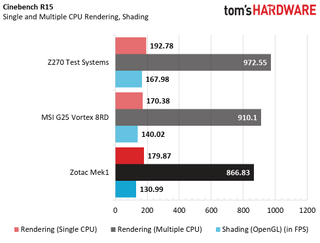
The locked Core i7 CPU inside the Mek1 may not perform as well as our Z270 test bed’s unlocked (yet stock-clocked) Core i7 from the same processor generation, but it does have moderate chops in single-threaded workloads versus the MSI G25 Vortex’s 8th Generation, six-core Core i5-8400 processor. However, the multi-threaded Rendering and OpenGL Shading tests put the Mek1 at the back of the pack.
CompuBench

The Mek1 performs well in the CompuBench tests. Although it falls behind the other systems in the field in the Video Processing portion of the benchmark (which relies heavily on CPU performance), the Bitcoin Mining test puts the Mek1 between our testbed’s GTX 1080 and 1070, where it should be with anything that showcases GPU performance.
Storage Test


As we mentioned earlier, when we first received the Mek1, Zotac was incorrectly advertising the primary SSD storage as an NVMe PCIe x4 SSD (and on the box, as a SATA SSD). The Phison PS5008-E8 M.2 NVMe SSD under the hood is actually a PCIe 3.0 x2 SSD with half of the potential bandwidth of a x4 device.
Now, it still provides speedy boot and loading times. However, at a low queue depth (QD2, which is reflective of normal user workloads), the Mek1’s SSD doesn’t perform any better than our test rig’s 2.5” SATA SSD (a Kingston HyperX Savage) and the MSI Vortex’s Samsung PM871 client M.2 SATA SSD. At a higher queue depth, the Phison SSD will perform more like what you would expect from a NVMe SSD. (We saw better results at QD32, not pictured.) But average consumers won’t notice a difference between the two types of SSDs in most workloads.
Sandra Memory Bandwidth


The Mek1’s 16GB (2 x 8GB) kit of DDR4-2400 doesn’t perform quite as well as our test rig’s DDR4-2133 in the Sandra memory-bandwidth test. This is due to the Mek1’s higher CAS latency (17-17-17-39), which succumbs to our reference platform’s tighter 15-15-15-36 timings. The Vortex’s single 16GB module of DDR4-2400 memory sports the same CAS latency as the Mek1, but it lags behind systems with dual-channel memory operation in workloads that are bandwidth-intensive.
PCMark 8
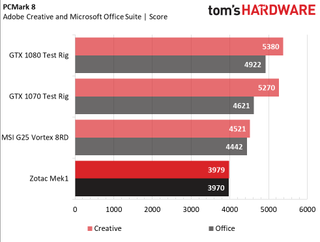
The Mek1’s weaker storage and ho-hum memory bandwidth play a role in its lesser-by-comparison performance in the PCMark 8 application benchmarks. Although the CPU performance should have pushed the Mek1 ahead of the MSI Vortex, the storage adversely affects real-world application workloads for Microsoft Office and Adobe Creative Suite, placing the Zotac offering at the bottom of the heap.
PCMark 10 Extended

The synthetic workloads offered up in the PCMark10 Extended test show the Mek1 in a slightly better light. We see a better overall score than the Vortex thanks to the gaming portion of the test (where it rightfully bests even the GTX 1070-equipped reference PC). It still lags behind the GTX 1070 testbed overall, but it does offer up better performance in the Essentials section.
The Productivity and Digital Content Creation segments of the test expose the Mek1’s lesser storage and memory bandwidths. (It falls behind the otherwise less-powerful Vortex.) But average users won’t see much difference in performance in most of these kinds of applications. And most power users who depend on programs like these for a living wouldn’t be looking at the Mek1 to begin with.
VRMark
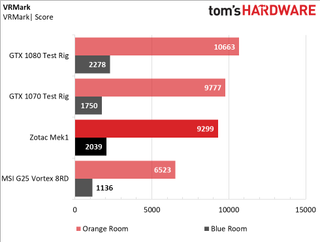
The VRMark test results highlight what’s to come in gaming performance, with the Mek1 failing to unseat the reference rig’s GTX 1070 (a better GPU) in the Orange Room test. However, Orange Room is mostly a baseline capability test, and it doesn’t tax the graphics card to the point where it becomes the bottleneck. The CPU performance will hold back the Mek1 in less-demanding VR applications and games. But if you feed it enough eye candy (like Blue Room does), you’ll see the Zotac offering take its familiar place between our GTX 1080 and GTX 1070 Z270 test beds.
MORE: Best PC Builds
MORE: How To Build A PC
MORE: All PC Builds Content
Current page: Synthetic & Productivity Benchmarks
Prev Page Introduction & Product Tour Next Page Gaming BenchmarksStay on the Cutting Edge
Join the experts who read Tom's Hardware for the inside track on enthusiast PC tech news — and have for over 25 years. We'll send breaking news and in-depth reviews of CPUs, GPUs, AI, maker hardware and more straight to your inbox.
-
bigdragon This is an impressively compact system given its performance. It's always nice to see attempts to minimize the footprint of a desktop system without compromising on performance.Reply -
MCMunroe I am a fan of the console sized PCs with full sized GPUs. I own a traditional tower (Deepcool Genome 2), a Alienware Alpha, and a Node 202 (about the same size as here). I really don't feel like I am missing anything in the Node, where as the Alpha is as upgradable as a laptop. Too me it's a new sweet spot.Reply -
velocityg4 Given the specs. There is no surprise about performance. A decibel reading under load would have been a useful addition for some people. If there was mention. I didn't notice it.Reply -
raymes0428 Can the stand be removed and it placed on its side? Looking for an Alienware M1 replacement.Reply
